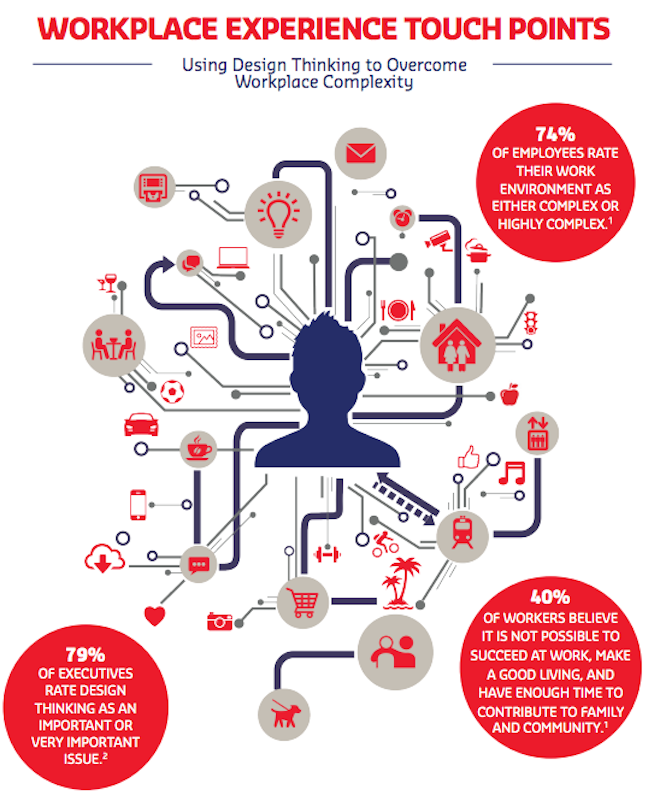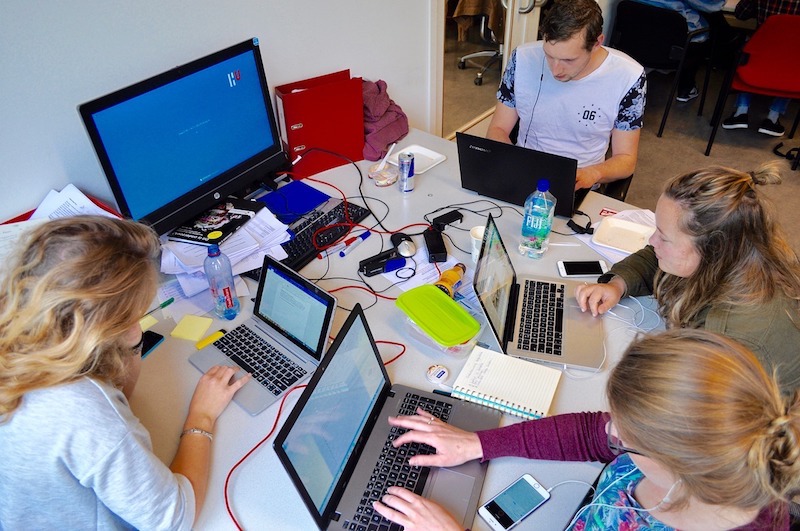The ubiquitous open office layout is “about to get a major makeover” that will emphasize coworking, personal development, and a reimaging of the workplace—including the role of the built environment and technology—with an eye toward putting workers first.
In its 90-page “2017 Global Workplace Trends” report, Sodexo—an international food services and facilities management provider whose 420,000 workers serve 10,000 companies in 80 countries—makes this prediction as part of a larger thesis that the ideal workplace is one that places a premium on its employees’ value, work-life balance, safety and comfort, health, and opportunities for growth.
Drawing on the knowledge and observations of 50 experts in business, academia, NGOs, research and trade groups, foundations and think tanks, Sodexo identifies three dynamics that are compelling changes in the workplace:
•The embrace of coworking, which structures work teams to be cross disciplinary;
•The “squashing” of generational stereotyping and the support of a culture of personal development, and
•A reimaging of the entire workplace, including the built environment, technology, and amenities, with the goal of improving conditions for workers.
“Technology and interactivity are increasingly shaping how people work as well as where,” the report states. “As work becomes more about adding value than cranking handles and pushing food carts, organizations are learning that communicating their values is imperative as their work to motivate and engage employees.”
Sodexo divides its 2017 report into 10 subject areas that touch on such topics as understanding the impact of migration on the workplace (the United Nations estimates that 3.3% of the world’s population are migrants, and 73% of them are working age), to how robotics is transforming the way people work (quoting a McKinsey Global Institute report that 45% of human work can be automated, and that two million jobs will be created by robots in the next eight years).
Designing people-focused workspaces
Readers from the AEC universe will take special note of the report’s chapters on how companies are putting design principles to work, and how they are unlocking Millennial talent.
 Many employees feel that their workplaces are too complex for them to succeed, or make it virtually impossible to balance their work and family lives. Image: Sodexo 2017 Global Workplace Trends.
Many employees feel that their workplaces are too complex for them to succeed, or make it virtually impossible to balance their work and family lives. Image: Sodexo 2017 Global Workplace Trends.
Sodexo cites Deloitte’s 2016 Global Human Capital Trends report, in which nearly 80% of executives surveyed rated “design thinking” an important or very important issue. And the current approach to experience design should be “the practice of designing a service, journey, or other component of the workplace with the focus on the employee throughout,” explains Dr. Rachel Permuth, Sodexo’s Global Vice President of Research-Corporate Services.
It’s imperative for companies to acknowledge that design thinking shouldn’t be confined within the four walls of an office. “The workplace experience begins at home, when workers are preparing to travel into the office, and ends when they are leaving for the day,” says Mark Newlands, Johnson & Johnson’s Global Workplace Experience Lead.
Good workplace design blurs the lines between work, play, and life. Health and well-being move to the foreground. And by improving a worker’s quality of life, the workplace experience can play a significant role in a company’s competing for and retaining their market’s best talent.
Design thinking also removes roadblocks that keep employees from being optimally efficient, and can overcome the perception among nearly three-quarters of employees polled that their work environments are overly complex. (In fact, two-thirds of companies also believe complexity is an obstacle to business success and productivity.)
Consequently, “getting buy-in from workers on design—i.e., reaching decisions collaboratively—yields the best design solutions and greatest acceptance from employees,” observes Randy Fiser, CEO of the American Society of Interior Designers.
The Sodexo report notes that as a people-centered, rather than process-centered, discipline, design thinking can be a catalyst for reorienting existing organizational roles. “HR, facilities management, corporate real estate, and IT should champion the discipline and tap into its signature skills of observation, empathy, and insight.”
How to make Millennials leaders: more mentorship
Millennials already make up a sizable portion of the global workforce, and could account for 75% of all employees by 2025. So companies ignore at their own peril a 2016 survey of 7,700 Millennials in 29 countries, which found that one in four would quit his or her job or do something different within the next year. (In fact, 20% of American Millennials did changes jobs within the past year.)
Part of the problem is the perception among Millennials that their jobs are dead ends. Another part of the problem is that what Millennials want is often hard to read: a 2014 survey of Millennials and Gen Z employees across 10 global markets found both generations saying healthcare was their most important benefit; two years later, in a follow-up study, their priorities had shifted to work flexibility—even though only 34% of companies now offer it.
Employers need to understand that what ultimately drives Millennials is the idea of YOLO: you only live once. “So the question for a Millennial becomes, if I only live once, why would I want to work for you?” says Crystal Kadakia, the author of “The Millennial Myth: Transforming Misunderstanding into Workplace Breakthroughs.”
While the consensus among employers is that Millennials make great managers, companies aren’t doing enough to prepare them for leadership roles. The 2016 Deloitte survey found that 63% of Millennials don’t believe their leadership skills are being fully developed. “Employers should be creating new experiences where Millennials can learn so they don’t feel like they’re stagnating,” says Elisabetg Kelan, Ph.D, Professor of Leadership at Cranfield University’s School of Management in the United Kingdom.
Kelan goes on to say that stagnation leads to disengagement, whose antidote is continuous feedback. “They have understood that only by receiving feedback can the be at the top of their game.”
Related Stories
Industry Research | Mar 3, 2022
AIA awards research grants to advance climate action
The American Institute of Architects (AIA) Upjohn Research Initiative is providing up to $30,000 to five research projects that will advance sustainability in architecture.
Industry Research | Mar 2, 2022
31 percent of telehealth visits result in a physical office visit
With little choice but to adopt virtual care options due to pandemic restrictions and interactions, telehealth adoption soared as patients sought convenience and more efficient care options.
Codes and Standards | Mar 1, 2022
Engineering Business Sentiment study finds optimism despite growing economic concerns
The ACEC Research Institute found widespread optimism among engineering firm executives in its second quarterly Engineering Business Sentiment study.
Multifamily Housing | Sep 1, 2021
Top 10 outdoor amenities at multifamily housing developments for 2021
Fire pits, lounge areas, and covered parking are the most common outdoor amenities at multifamily housing developments, according to new research from Multifamily Design+Construction.
Industry Research | Aug 19, 2021
BD+C Market Intelligence Reports
Exclusive research, data, and trends reports from the editors of Building Design+Construction.
Resiliency | Aug 19, 2021
White paper outlines cost-effective flood protection approaches for building owners
A new white paper from Walter P Moore offers an in-depth review of the flood protection process and proven approaches.
Multifamily Housing | Jul 7, 2021
Make sure to get your multifamily amenities mix right
One of the hardest decisions multifamily developers and their design teams have to make is what mix of amenities they’re going to put into each project. A lot of squiggly factors go into that decision: the type of community, the geographic market, local recreation preferences, climate/weather conditions, physical parameters, and of course the budget. The permutations are mind-boggling.
Digital Twin | May 24, 2021
Digital twin’s value propositions for the built environment, explained
Ernst & Young’s white paper makes its cases for the technology’s myriad benefits.
Industry Research | May 20, 2021
Latest ULI report forecasts robust real estate rebound
It’s going to take some time, though, for the office sector to recover
Industry Research | Apr 9, 2021
BD+C exclusive research: What building owners want from AEC firms
BD+C’s first-ever owners’ survey finds them focused on improving buildings’ performance for higher investment returns.

















